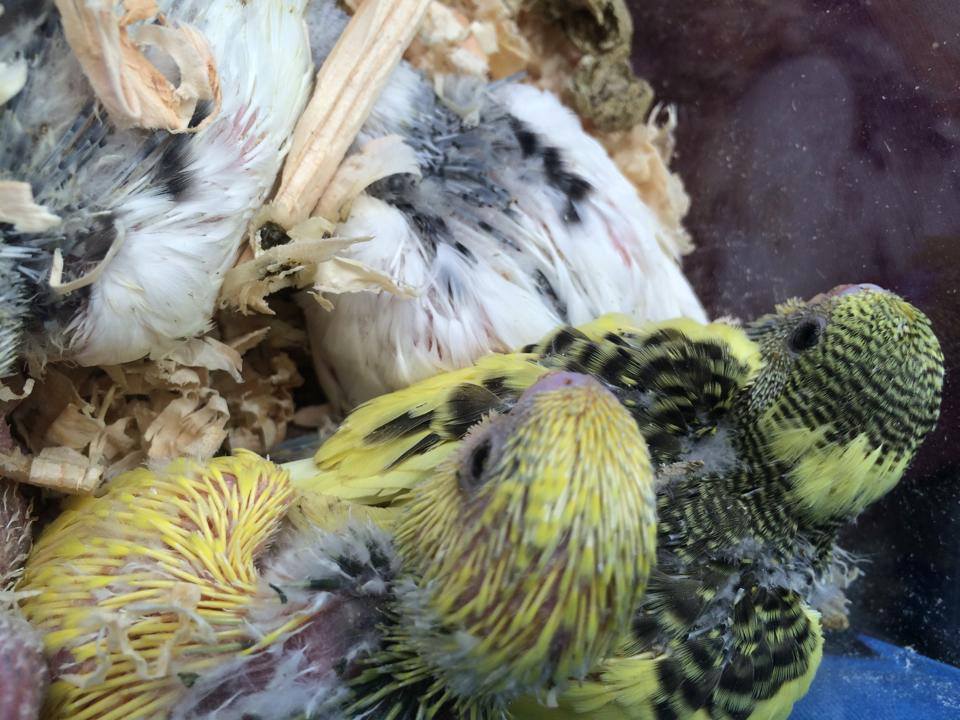We all know that we shouldn’t meet strangers off Craigslist alone, and that is why I accompanied my friend on her errand that day. She was responding to an ad for baby budgies, and honestly I was interested in seeing what mutations the man had available. When we arrived I noticed some concerning things even before I saw the birds. Several pit-bull type dogs on short chains or in small enclosures; all unneutered males or females who had obviously nursed puppies. The owner of the dogs and the birds was an elderly man who spoke broken English. He led us to his well maintained back yard where a home made aviary stood, divided into two sections each about the size of a large public bathroom stall. Perhaps four feet deep, six feet long, and six feet tall. In one half were five or six cockatiels, and in the other, perhaps 250 budgies. Maybe more. I have never seen birds packed into a space that small. There was not enough space for even half the birds to perch at a time. Many of the birds were missing toes, entire feet, and even huge chunks of their beaks. One bird was missing her entire upper mandible. I honestly don’t know how she was surviving.
Along the back wall of the aviary was a row of nest boxes. My friend asked to see the “baby parakeets” that had been advertised. The man explained that a lot of the birds were babies. They proceeded to discuss the fact that she had intended to buy babies young enough to hand feed. The man explained that the holes in the nest boxes were too small to get his hands inside, and that the boxes didn’t have doors. We were stunned. He had told us the aviary was about 5 years old; for five years clutch after clutch of babies had been born, and he had NEVER cleaned them out. We eventually convinced the man to pry the front board off the boxes to get at the babies by agreeing to buy 10 adult birds.
When he opened the boxes I nearly vomited. There were dead babies in some, and in the others there were babies covered in feces, some of which were so encased in poop that they couldn’t use their feet. At this point my friend began to have second thoughts; she had intended for these babies to be her first experience in hand feeding, but now doubted her abilities to take on babies already in such extreme physical distress. I, on the other hand, who had initially said I was NOT going to dive into hand feeding at the moment, couldn’t let the babies go back into the boxes. We took eight babies and 10 adult birds. We had to pull into a parking lot on the way home because both of us were shaking and fighting tears.
We got them home and began the extremely long process of removing their caked on filth. What we found beneath was damage we couldn’t have imagined. The feces had actually warped the beaks to the point that one of them was actually turned upward. We ended up calling that one “Ducky” because it was nicer than “Shovel Face.”
What followed was weeks of learning on the go. In our desperation to save them, we had taken mostly babies who were really too old to begin hand feeding. As a result we found ourselves force feeding. Neither of us had hand fed before, we didn’t know what we were doing beyond the information we could find online. Force feeding is dangerous, and it is a miracle we didn’t aspirated one of the babies. We also struggled with keeping the temperature of the formula consistent. We were feeding every 2 hours and it was taking 45 minutes per feeding. We were feeding this often because we couldn’t get much food into them at each feeding. Now we know that such frequent feedings were likely part of the reason we had to force them. We were truly clueless. The idea that “everyone has to start somewhere” and that because of this the best way to learn hand feeding is by trial and error is ridiculous. We needed to be shown how to do it and be supervised. But we weren’t, and we did the best we could with the knowledge we had. Because we were already force feeding most of the babies we couldn’t tell the difference in appetite when one of them got very ill. She had a yeast infection in her mouth and we didn’t notice it in time to save her. A second baby died mysteriously a few days after weaning. Nine of the ten adults had died within two weeks.
We called the Hawaiian Humane Society the day we brought the babies home. An inspection was done and we were informed that because all the animals on the property were fed, watered, and sheltered, that nothing was wrong. A local dog rescuer got involved and, out of his own funds, purchased all the birds and the aviary; thus removing the means of the man to breed, at least on such a large scale. He had confided in us that his health was failing, and that the couple had recently suffered the death of an adult child. We were fairly confident that he wouldn’t have the means or ability to build again. The rescuer was in continuing contact with the man in hopes of convincing him to allow the dog rescue organization to spay and neuter his dogs for free. The birds were removed to permanent sanctuary.
Six babies remained, and as they grew their beaks started to straighten and they were able to eat solid food. We found homes for them with the strictest instructions that we would take them back if the new owners decided not to keep them for ANY REASON. Four babies had gone to one family and two to another. We learned a lot, made a lot of mistakes, but in the end we did the best we could. Doing something is better than doing nothing, but if I had it to do over again I would do a lot of things differently and not dived into a situation I was completely unprepared for.


Leave a Reply